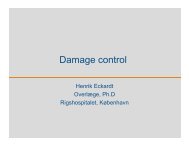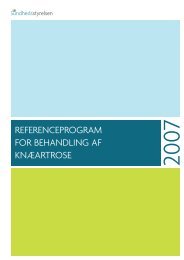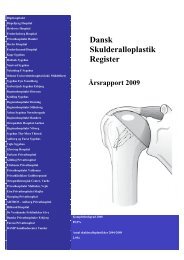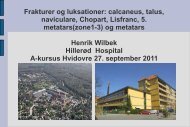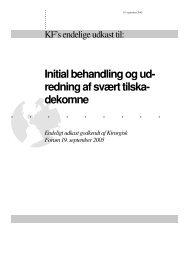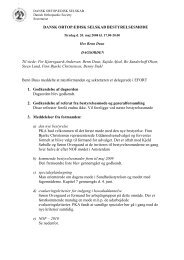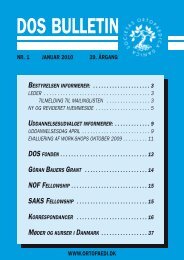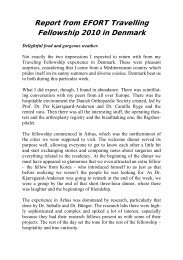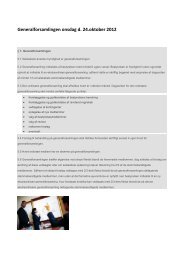DOS BULLETIN - Dansk Ortopædisk Selskab
DOS BULLETIN - Dansk Ortopædisk Selskab
DOS BULLETIN - Dansk Ortopædisk Selskab
Create successful ePaper yourself
Turn your PDF publications into a flip-book with our unique Google optimized e-Paper software.
2010-378_<strong>DOS</strong> nr. 3 2010 29/09/10 10:08 Side 122<br />
Increased wear of polyethylene coupled with yttriastabilized<br />
zirconia femoral heads.<br />
A 10 year follow-up and clinical assessment<br />
Maiken Stilling, Kjeld Anton Nielsen, Kristian Larsen, Kjeld Søballe:,<br />
Ole Rahbek<br />
Aarhus University Hospital; Randers Regional Hospital;<br />
Holstebro Regional Hospital<br />
Background: Experimental studies predicted zirconia femoral heads to reduce the wear<br />
of conventional ultra high molecular weight polyethylene (UMHWPE) in total hip<br />
arthroplasty (THA). Later on, it was discovered that frictional heating and mechanical<br />
stresses on THA bearings surfaces during clinical use resulted in phase transformation<br />
of yttria-stabilized zirconia (YSZ) and initiated surface roughening of the femoral head.<br />
Purpose: We hypothesized increased PE wear- rate and poorer clinical outcome at 10<br />
years for PE coupled with YSZ femoral heads in comparison with PE coupled with<br />
Cobalt-Chrome (CoCr) femoral heads.<br />
Methods: 71 patients (76 hips) at a mean age of 52 years (range, 24 – 64) were treated<br />
by one surgeon for hip arthritis by primary THA during 1996-1999. 61 patients (66 hips)<br />
participated in a 10 year follow-up (nonparticipants: 7 dead, 2 early revisions, and 1 with<br />
poor health). There were 32 hips with CoCr and 34 hips with YSZ femoral heads. Components<br />
were cementless HA coated MH-Solid Finned Ringloc Shells (Biomet), Arcom<br />
PE liners (Biomet), cemented Exeter stems (Stryker), and 28 mm CoCr and YSZ femoral<br />
heads (Stryker). The two cohorts were compared at 10 years for two- dimensional (2D)<br />
linear PE wear, osteolysis, clinically by three questionnaires (Self-report Harris Hip<br />
Score (HHS), SF-36, and EQ-5D) and demographic data.<br />
Findings: Demographic data was comparable. At 10 years, the 2D linear PE wear-rate<br />
with YSZ femoral heads (n = 34) of 0.16 mm/year, SD 0.05 (range, 0.06 – 0.30) was 25%<br />
higher (P < 0.01) than with CoCr femoral heads (n = 32) of 0.12 mm/year, SD 0.06<br />
(range, 0.03 – 0.30). Variance was similar (P = 0.31). Maximum 2D linear wear was 2.8<br />
mm in both cohorts. There were 2 revisions in the YSZ group within the observation period<br />
(P = 0.26). There were no evident cup migration and osteolysis was minimal. In the<br />
group with YTZ femoral heads (n = 33) HHS was 90 and EQ-5D was 0.88 (P > 0.25). In<br />
the group with CoCr femoral heads (n = 27) HHS was 87 and EQ-5D was 0.87 (P ><br />
0.25). For SF-36 the two physical dimensions were poorer for the two cohorts compared<br />
with the Danish background population aged 45 – 54 years) (P < 0.01). In general 93%<br />
of the patients (n = 60) were satisfied with the THA.<br />
Conclusion: YSZ femoral heads resulted in a 25% higher PE wear-rate compared with<br />
CoCr femoral heads, but it did not influence the THA revision rate, the health-related<br />
life-quality, and disease- specific measures at 10 years of follow- up. Clinical long-term<br />
follow-up of YSZ femoral heads do not reflect the positive wear-profile, which experimental<br />
studies predicted. YSZ femoral heads have now all but completely disappeared<br />
from the market, however, thousands of patients are still implanted with YSZ femoral<br />
heads and clinicians should pay attention to wear-related problems of in these patients.<br />
122



